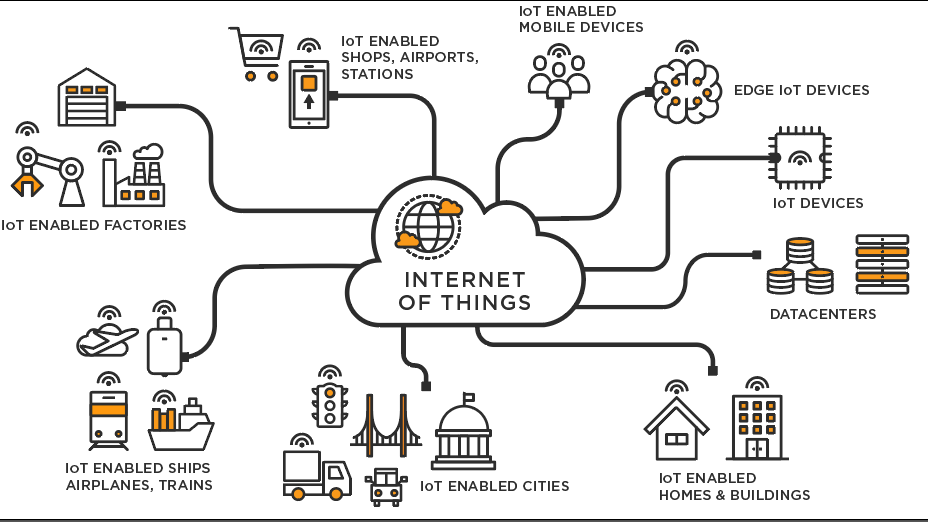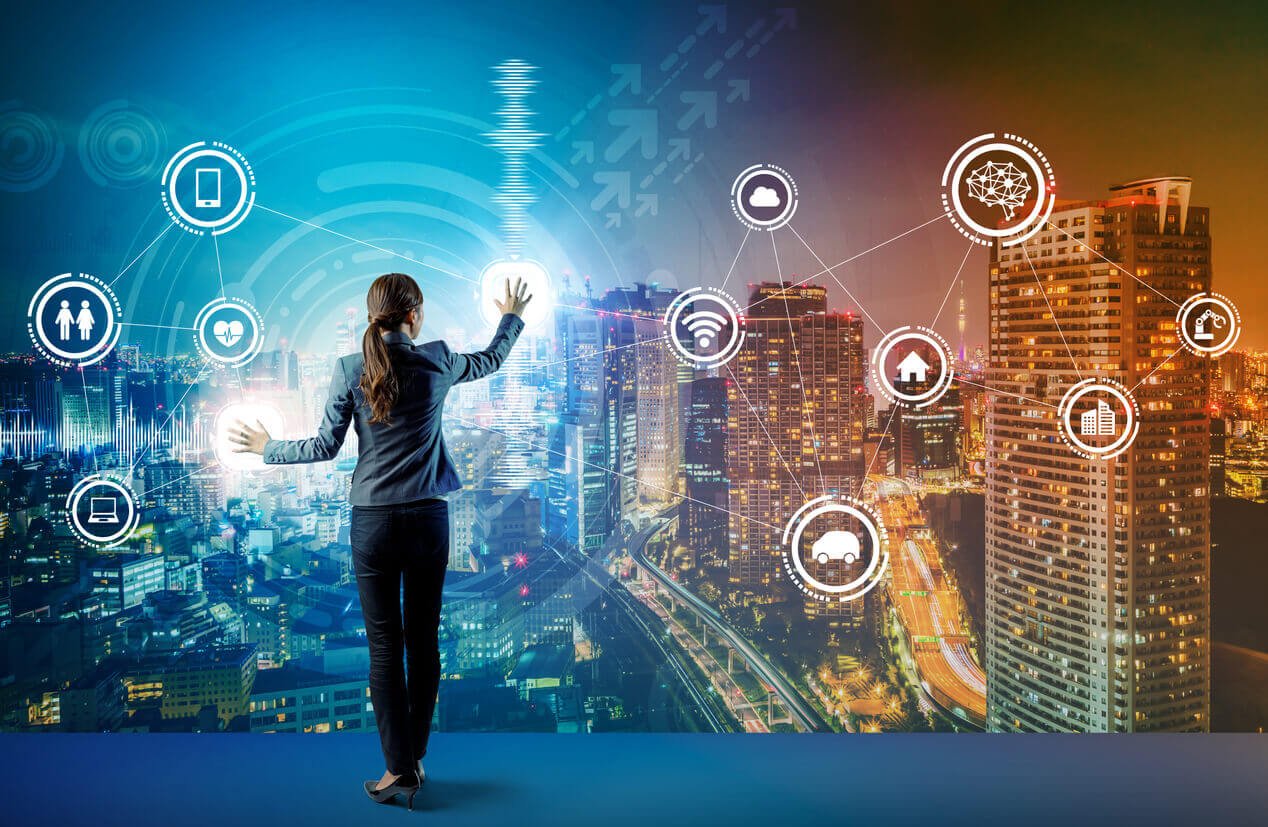The Internet of Things, In today’s world, we are surrounded by smart gadgets that make life more convenient. From wearable fitness trackers to voice-activated virtual assistants, we live in a time where devices can communicate with each other without human involvement. This remarkable development is called the “Internet of Things” or IoT. In this blog, we’ll explore what IoT is, how it works, its importance, and what the future holds.
What is the Internet of Things?
The Internet of Things (IoT) refers to a network of physical objects—devices, vehicles, home appliances, and other items—that are embedded with sensors, software, and connectivity capabilities, allowing them to collect and exchange data over the internet. Simply put, IoT connects things to the internet, so they can “talk” to each other and take actions without needing a human in the loop.
For example, a smart thermostat can adjust your home’s temperature based on your preferences or even learn from your habits to create a personalized heating schedule. A smartwatch can track your heart rate and send that information to a healthcare app that can alert you if something seems off. These devices are all part of the Internet of Things.
How Does IoT Work?
The technology behind IoT is fascinating but not too complicated. Here’s a simple explanation:
- Sensors: IoT devices use sensors to gather data. For example, a smart fridge might have temperature sensors to check how cold it is inside.
- Connectivity: The data collected by the sensors is sent to the internet using Wi-Fi, Bluetooth, or other network technologies. Once connected, the data can be shared with other devices or stored in the cloud.
- Data Processing: After the data reaches its destination, software processes the information. This can be something simple, like adjusting your house’s temperature based on your location, or something more complex, like a self-driving car using data from multiple sensors to navigate the road.
- Action: Once the data is processed, the device may take action. For example, your smart light bulb might turn on when it senses you’ve entered the room.
Why is IoT Important?
IoT has revolutionized the way we live, work, and play by making our environments more efficient and smarter. But why is IoT so important?
- Automation: IoT enables automation, reducing the need for manual intervention. For instance, smart irrigation systems can water crops based on weather conditions, helping farmers save time and resources.
- Efficiency: IoT increases efficiency. By having real-time data, businesses can optimize processes, cut costs, and reduce waste. In manufacturing, IoT-powered machines can detect problems before they cause downtime, improving productivity.
- Convenience: IoT brings convenience to everyday life. Imagine being able to control your home’s lighting, temperature, and security from a single app on your smartphone. Or how about ordering groceries by simply speaking to your fridge?
- Better Decision-Making: By collecting and analyzing data, IoT helps people and businesses make better decisions. For example, a fitness tracker can give you insights into your health, while smart cities can use traffic data to reduce congestion.
Everyday Examples of IoT
Now that we’ve talked about how IoT works and its importance, let’s look at some real-world examples of IoT in action:
1. Smart Homes
One of the most common uses of IoT is in smart homes. Devices like smart thermostats, light bulbs, and security cameras can be connected to the internet and controlled remotely. This means you can lock your door, turn off the lights, or adjust your home’s temperature even when you’re not there. These devices not only provide convenience but also help save energy.
2. Wearable Devices
Wearable tech, such as fitness trackers and smartwatches, is another great example of IoT. These devices can track your steps, monitor your heart rate, and even analyze your sleep patterns. The data they collect is sent to an app, where you can see your progress and make changes to your daily routine.
3. Smart Cities
IoT is playing a huge role in building smart cities. Traffic lights can be adjusted based on real-time traffic data to reduce congestion. Smart trash bins can notify sanitation workers when they’re full, reducing unnecessary pickups. These innovations help cities run more smoothly and sustainably.
4. Healthcare
In healthcare, IoT is used to monitor patients remotely, manage medication, and provide doctors with real-time data. For example, smart pills can send data about a patient’s digestive system, while wearable health monitors track vital signs like blood pressure and glucose levels. This technology helps doctors provide better care and allows patients to manage chronic conditions more easily.
The Challenges of IoT
While IoT offers many benefits, it’s not without its challenges. Here are some of the main issues the IoT industry is working to address:
1. Security and Privacy
With so many devices connected to the internet, cybersecurity is a big concern. Hackers could potentially gain access to personal data or even control critical systems. Protecting the privacy and security of IoT devices is essential to ensure that users feel safe.
2. Interoperability
Not all IoT devices are compatible with each other. For example, a smart fridge from one company might not work with a smart oven from another. Creating standards that allow different devices to work together is crucial for IoT to reach its full potential.
3. Data Overload
With millions of devices collecting data, managing and analyzing all this information can be overwhelming. Companies need to invest in powerful data analytics tools and storage solutions to handle the enormous amounts of data generated by IoT devices.
The Future of IoT
The future of IoT is incredibly promising. According to some estimates, the number of IoT devices worldwide could exceed 75 billion by 2025. With such rapid growth, IoT will continue to revolutionize industries and everyday life in ways we can only imagine.
1. 5G and IoT
The rollout of 5G networks will significantly boost the IoT ecosystem. With faster internet speeds and lower latency, 5G will allow more devices to connect and share data more quickly. This will enable innovations like fully autonomous vehicles and advanced smart cities.
2. AI and IoT
Artificial intelligence (AI) and IoT are a perfect match. With AI, IoT devices can become even smarter by learning from the data they collect. For example, AI can help smart home devices predict your needs or enable autonomous drones to navigate complex environments.
3. IoT in Healthcare
As healthcare technology advances, we’ll likely see more IoT devices being used to monitor and improve patient care. Remote monitoring will become more widespread, reducing the need for hospital visits and enabling better management of chronic diseases.
Conclusion
The Internet of Things is transforming the world as we know it. From smart homes and cities to wearable technology and healthcare, IoT is making life more convenient, efficient, and connected. However, challenges such as security and data management need to be addressed to fully realize IoT’s potential. As technology continues to advance, the future of IoT is bright, and its impact on industries, daily life, and the global economy will only continue to grow.
By simplifying tasks and bringing automation to our lives, IoT is not just a trend; it’s shaping the future. Whether in our homes, businesses, or cities, the Internet of Things is here to stay, and its potential is only beginning to be realized.




